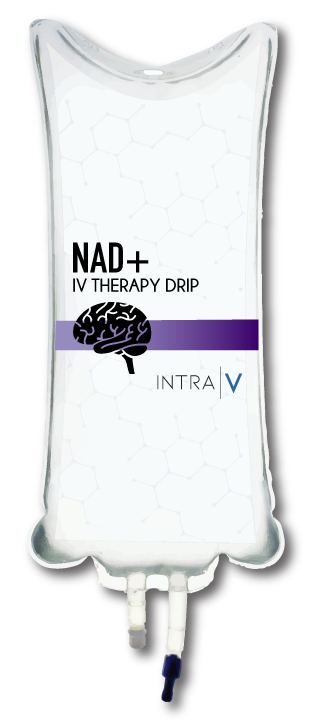NAD+ IV Therapy
Do you want to turn back time?
What if there was a compound that could:
- Reverse depression
- Improve athletic performance
- Help curb cravings for alcohol and drugs
- Turn back time
- Restore energy
- Clear brain fog
Unfortunately, age, medications, chronic illnesses, stress, drugs, and alcohol can all contribute to a decrease in your NAD+ stores. As NAD+ goes down, so does our energy, causing your cells to start to age and deteriorate. At our office in Knoxville NAD + IV Therapy treatments are here for patients who need more energy for their daily lives or need relief from the effects of a chronic illness. During your consultation, your provider will conduct a thorough medical history, including blood work, to help determine a proper treatment plan that meets your nutritional and cellular needs.

What is NAD IV Therapy?
Using IV infusion therapy, we administer this anti-aging compound directly into your blood circulation, so your cells have access to as much as they need.
Compelling research has shown that supplementing with NAD+ may help you withdraw from addictive substances safely, overcome anxiety and depression, handle acute and chronic stress more effectively, and cope better with PTSD. This IV aims to undo that process by replenishing NAD+. NAD+ is known as a “helper molecule” because of how it binds to other enzymes to “help” or activate them to generate a reaction on a molecular level. NAD+ is critical to live. Supplementing NAD+ through IV therapy helps your body fight against illness and slows down the aging process. By delivering NAD IV Therapy Knoxville patients are getting the only way to ensure they receive 100 percent bioavailability from this molecule.
Is NAD+ the fountain of youth?
NAD+ Benefits
It could be. More research needs to be done. But one thing seems clear—It certainly has an impact on your body at the cellular level, and it may just turn back the hands of time. NAD+ IV Therapy benefits include:
- Anti-aging
- Exercise Endurance
- Drug/Alcohol Addiction
- Neurodegenerative Disorders
NAD+, which occurs naturally in every cell in your body, may protect DNA, slow down aging and help restore function due to its effects on the genes that govern aging. Clinics across the US are starting to use IV infusions of NAD+ to help people withdraw from drug and alcohol addiction with minimal symptoms in as little as 7-14 days of treatment. These individuals report feeling calm and content and say they lost their “cravings” after an entire course of treatment. Between 3-14 consecutive days of NAD+ therapy combined with amino acid infusions, minerals, and B-Vitamins are typically recommended for full effect. Your NAD+ Knoxville treatment is tailored to your individual needs after a detailed consultation.

Am I a good candidate for NAD+ IV Therapy?
If you feel sluggish, constantly tired, feel like your brain is foggy, or have no energy to do anything, NAD+ IV Therapy may be right for you. NAD+ can replenish your NAD storage levels and help those who suffer from certain chronic conditions.
However, you don’t have to have something wrong for you to reap the benefits of NAD+. Healthy people, along with athletes, will see enhanced improvement in their performance and endurance levels. NAD+ also helps to reduce recovery time after intense exercise or injury.
Science — If you want the
science behind it!
The nicotinamide adenosine dinucleotide (NAD) molecule alternates between two forms. Which one is present depends on how it is being utilized. NAD+ is the reduced (active) form of the molecule. NADH is the oxidized (inactive) form of the same molecule.
Energy production in your mitochondria—the little energy factories that pump out ATP—ABSOLUTELY depends on NADH (the inactive form) being recycled back to active NAD+. If this recycling stops and NADH accumulates, the cell runs out of energy and may die. This was clearly shown in a recent study on brain and kidney cells.1 Then, depleted levels of NAD+ and accumulation of NADH, or a low ratio of NAD+/NADH, can create problems for your mitochondria and your cells. Indeed, it results in low levels of cellular energy and may be one of the primary contributing factors to “mitochondrial dysfunction,” a condition we now know is implicated in a wide variety of chronic illnesses, including autoimmune disorders, diabetes, and others. Restoring NAD+ levels reverses this process and allows cells to return to full energy status, offering a possible way to undo mitochondrial damage and the resulting chronic illness.
NAD+’s Role in Exercise and Endurance
It is well known that ATP levels get depleted in muscles while exercising. This simply stands to reason. However, until recently, we didn’t realize how NAD+ was implicated in this process. A study done in 2010, using both trained and untrained healthy volunteers, helped tease out the relationship. The researchers showed that intense exercise decreases NAD+. When the study participants took an antioxidant supplement containing pycnogenol (which stimulates NAD+ production and protects it from turning into the inactive, oxidized form of the molecule), NAD+ levels increased, and exercise performance and “time to fatigue” also improved.
NAD+ as an Anti-Aging Molecule
Medical researchers have long known that a group of enzymes called sirtuins play a crucial role in how the body ages—especially SIRT1 and SIRT3. We don’t yet precisely understand how they work, but what we know is exciting. SIRT enzymes appear to switch off genes that promote aging, such as those that cause inflammation, fat synthesis and storage, and blood sugar management issues.
Up until now, the only way we knew to positively impact these SIRT enzymes was to go on a very low-calorie diet. As uncomfortable as it may be, caloric restriction is one of the few ways that has repeatedly been shown to lead to a longer life. However, the tide appears to be turning. You see, recent research indicates that NAD+ plays a crucial role in the creation and activation of the sirtuins. Doctors out of the Department of Developmental Biology at the Washington University School of Medicine were the first to show this link in 2014.2
The authors note:
“NAD(+) levels decline during the aging process and maybe an Achilles’ heel, causing defects in nuclear and mitochondrial functions and resulting in many age-associated pathologies. Restoring NAD(+) by supplementing NAD(+) intermediates can dramatically ameliorate these age-associated functional defects, counteracting many diseases of aging, including neurodegenerative diseases.”
“NAD(+) levels decline during the aging process and maybe an Achilles’ heel, causing defects in nuclear and mitochondrial functions and resulting in many age-associated pathologies. Restoring NAD(+) by supplementing NAD(+) intermediates can dramatically ameliorate these age-associated functional defects, counteracting many diseases of aging, including neurodegenerative diseases.”
NAD+’s Role in Reversing Chronic Illness and Neurodegenerative Disease
Health and energy production are intimately related. If your mitochondria aren’t functioning or they are producing too little energy, you will experience symptoms. When the problem becomes too severe, it turns into illness.
Low ATP levels quickly deplete your cell’s energy reserves. Left unchecked, this can lead to cell death. How all of this shows up in your body depends on which cells are being affected. If nerve cells are affected, the lack of energy may manifest as depression, anxiety, fatigue, and lack of focus. In severe cases where the nerve cells are dramatically impacted or even die, neurodegenerative illnesses like Parkinson’s disease and Multiple Sclerosis may manifest. In the worst cases—like mass cellular death—this may lead not only to transient symptoms such as tremors, spasms, tingling, numbness, and blurred vision but to permanent, irreversible disability. If your heart cells are affected, it can lead to cardiovascular disease.
Additional Reading
The link between NAD+, energy production, and chronic illness really couldn’t be more precise. Low NAD+ results in low ATP levels. If your lung cells are affected, pulmonary disorders may present themselves. When the cells in your organs and tissues don’t have enough energy, illness results. IV NAD+ combined with IV amino acids can be beneficial in restoring energy production—especially in the nerve tissue—and may even prevent permanent damage. One 2014 study showed that rat nerve cells pre-treated with high concentrations of NAD+ before being deprived of oxygen survived the challenge and recovered much faster than cells not bathed in the extra protective NAD+.4 A more recent review article published in 2015 builds on this. Some of the conditions which may benefit from NAD+ infusion therapy include.
- Fibromyalgia
- Chronic Fatigue
- Multiple Sclerosis
- Parkinson’s disease
- Alzheimer’s disease
- Mitochondrial Dysfunction
After scientists examined all of the available scientific evidence, they recommended NAD+ supplementation and restoration as a new therapeutic opportunity for a wide variety of neurodegenerative diseases.5
NAD+’s Role in Addiction
Perhaps the most exciting and controversial use medicine has found for NAD+ so far is in the treatment of drug and alcohol dependency. Despite the controversy, the basic science is sound, and the early results are extraordinary. Knoxville NAD+ patients are reporting total recovery from addiction within 7-14 days with no subsequent craving for their substance of choice and few withdrawal symptoms.
To understand NAD+’s relationship to drug and alcohol abuse, let’s look at its role in the metabolism of alcohol. After you drink, your body tries to process and eliminate every molecule of alcohol. This is done in the liver, where ethyl alcohol is converted to acetaldehyde. NAD+ is critical to this process. Alcohol donates one hydrogen molecule IRREVERSIBLY to NAD+, converting it to NADH. That NAD+ molecule is now gone, and the NADH in your system begins to build. As this happens repeatedly, the NAD+/NADH balance swings out of favor, and serious problems can occur. In a 2012 review article, the authors conclude that it is this NAD+ depletion and NADH accumulation that disables the mitochondria in your liver cells from being able to make energy ATP.6 This leads to liver cell death. Your body is then even less capable of processing the alcohol out of your system, which may set the stage for chemical dependency.
Building on this principle, several addiction clinics in the United States have been using IV NAD+ combined with IV amino acid therapy with great success. For example, Dr. Ken Starr of the Wellness Group in San Luis Obispo and Dr. Metsayer of the Springfield Wellness Clinic in Louisiana have been using a combination of daily IV infusions of NAD+ and amino acids for treatments lasting 10-14 consecutive days to drastically alleviate the symptoms of withdrawal from opiates, benzodiazepines, and alcohol. Their therapy, termed “Brain Restoration” (BR+), is often combined with traditional medications such as suboxone and naltrexone to achieve a much smoother transition to sobriety with drastically fewer unpleasant symptoms. Yet, remarkably, many of their patients report the subjective loss of “craving” for the drug previously abused after the NAD+ and amino acid combination therapy.
Schedule your Knoxville, NAD+ IV Therapy consultation at RevitalyzeMD
Regenerative Medicine Personalized for you
Dr. Debra Durst is a double board-certified physician specializing in regenerative medicine with personalized IV Therapy treatments to help your body on a cellular level Revitalyze your life. At our office in Knoxville NAD+ IV Therapy is one of our many specialties, but we do offer Virtual Visits for your initial consultation. Learn more about NAD+ IV Therapy and its many benefits to replenish your NAD storage levels for overall wellness.
References
1. Chance, Britton, et al. “Intracellular Oxidation-Reduction States in Vivo The microfluorometry of pyridine nucleotide gives a continuous measurement of the oxidation state.” Science 137.3529 (1962): 499-508.
2. Imai, Shin-ichiro, and Leonard Guarente. “NAD+ and sirtuins in aging and disease.” Trends in cell biology 24.8 (2014): 464-471.
3. Mach, John, et al. “The Effect of Antioxidant Supplementation on Fatigue during Exercise: Potential Role for NAD+ (H).” Nutrients 2.3 (2010): 319-329.
4. Shetty, Pavan K., Francesca Galeffi, and Dennis A. Turner. “Nicotinamide pre-treatment ameliorates NAD (H) hyperoxidation and improves neuronal function after severe hypoxia.” Neurobiology of disease 62 (2014): 469-478.
5. Verdin, Eric. “NAD+ in aging, metabolism, and neurodegeneration.” Science 350.6265 (2015): 1208-1213.
6. Cederbaum, Arthur I. “Alcohol metabolism.” Clinics in liver disease 16.4 (2012): 667-685.


